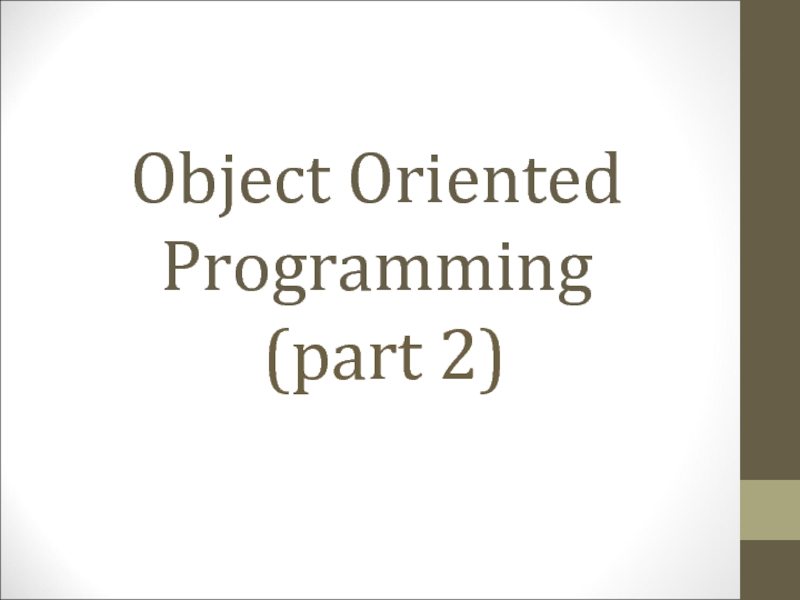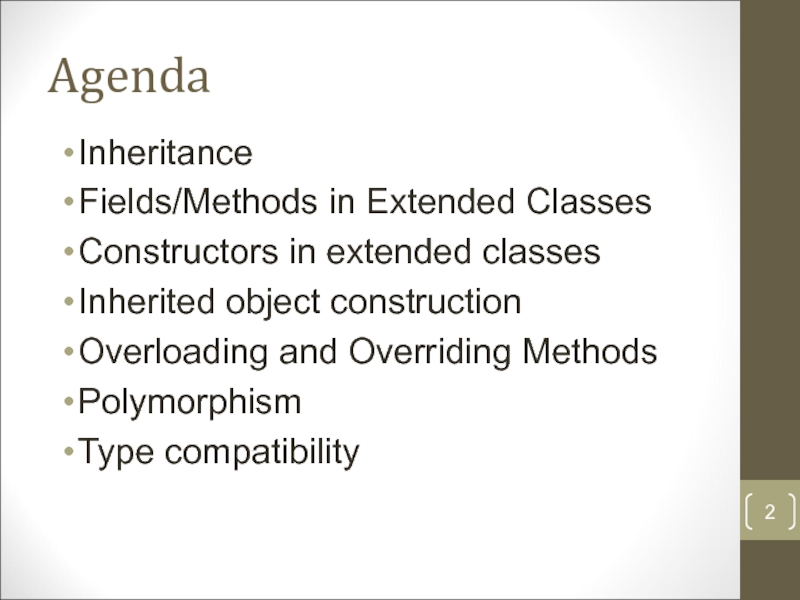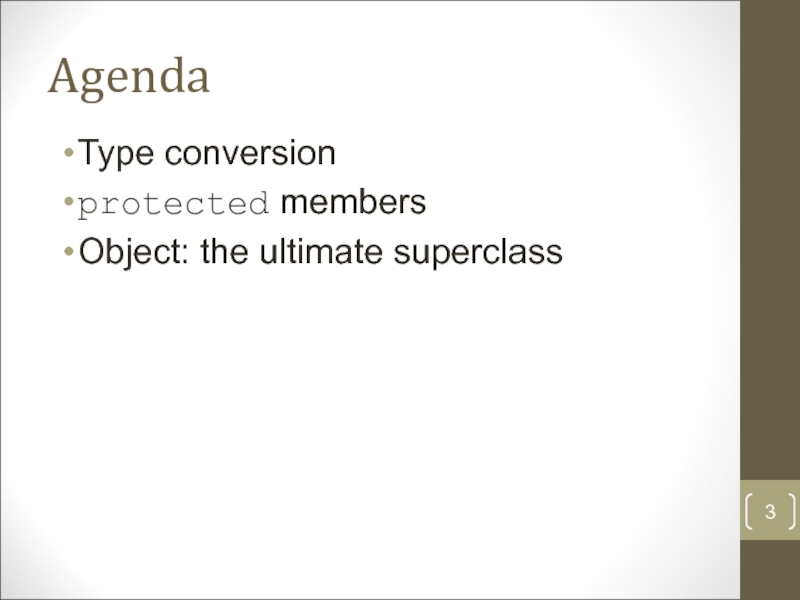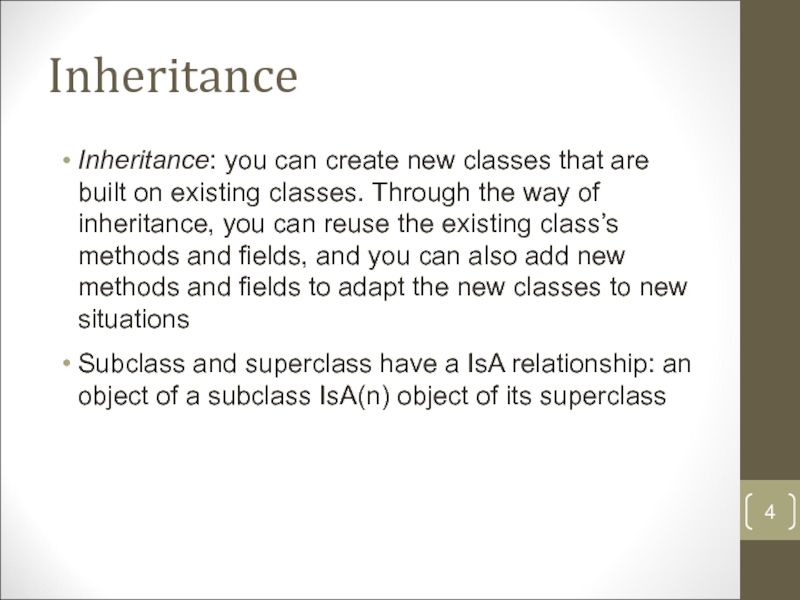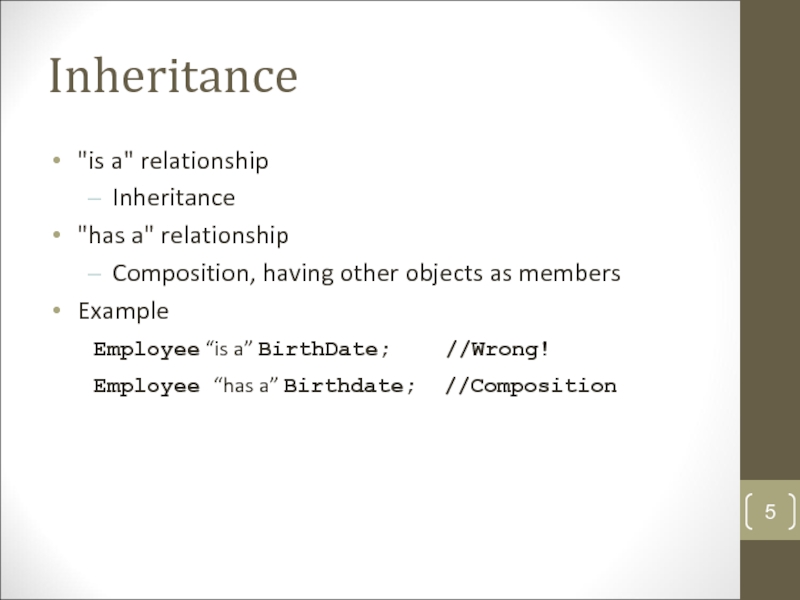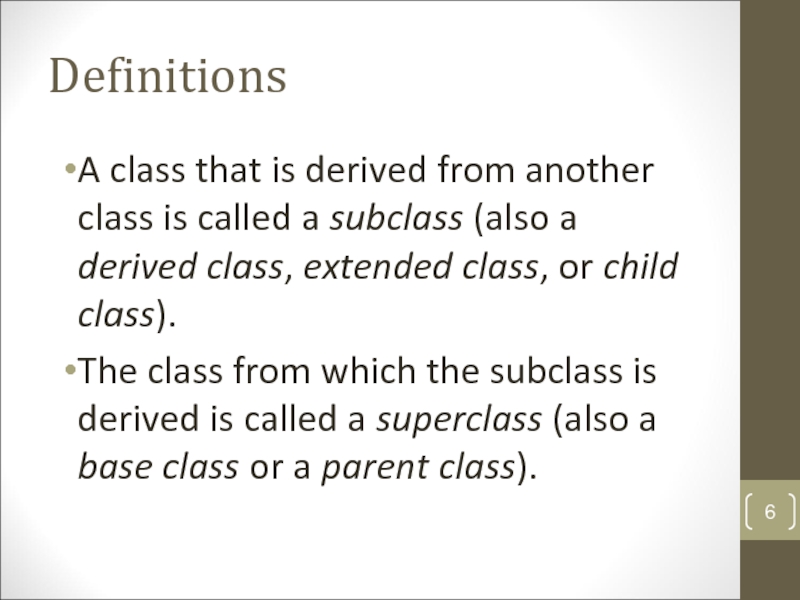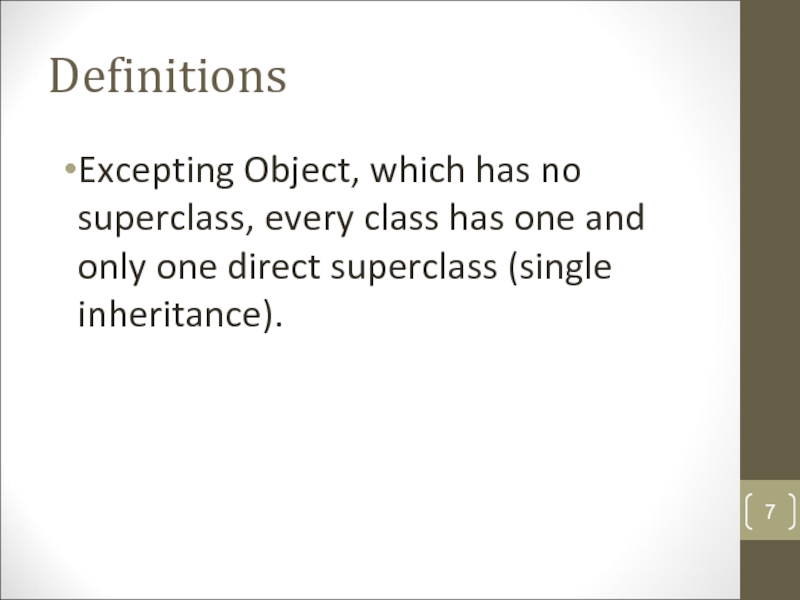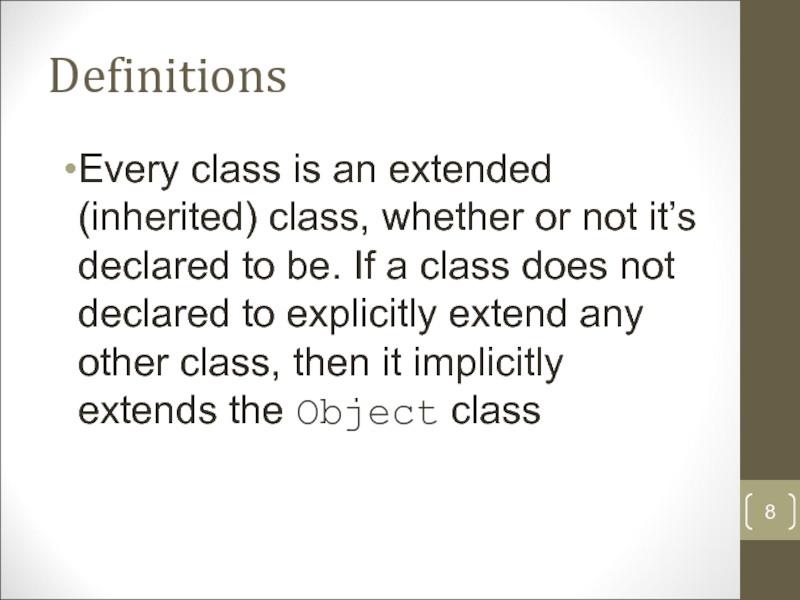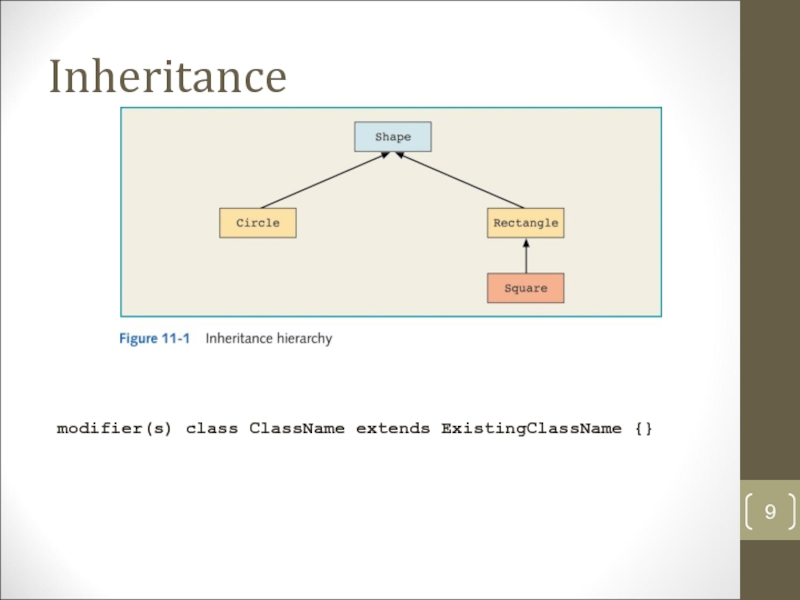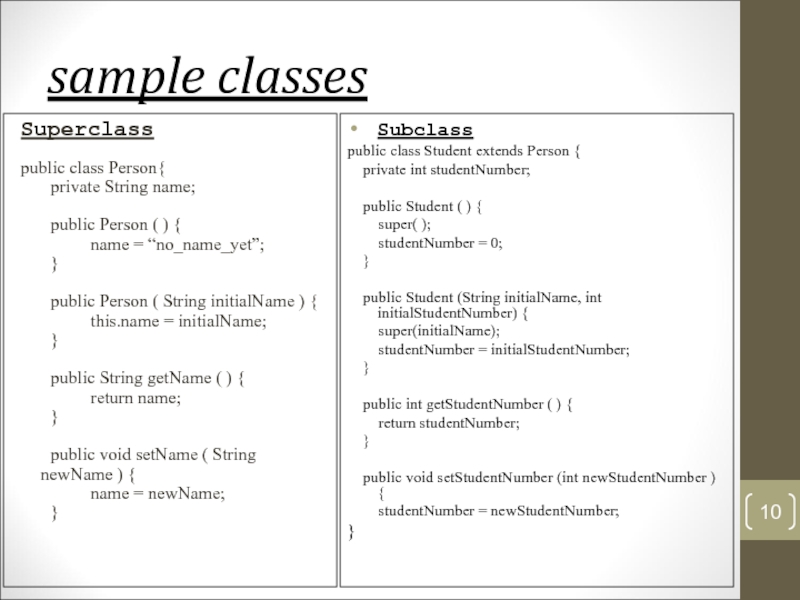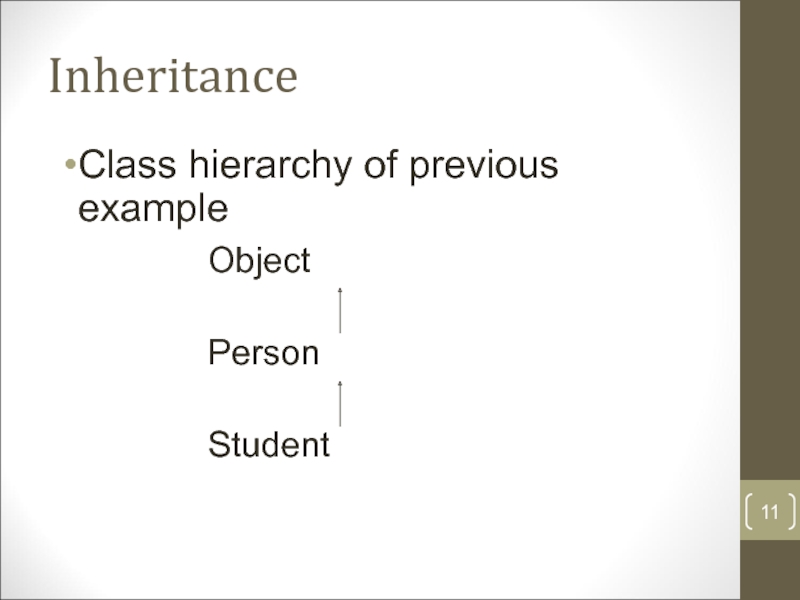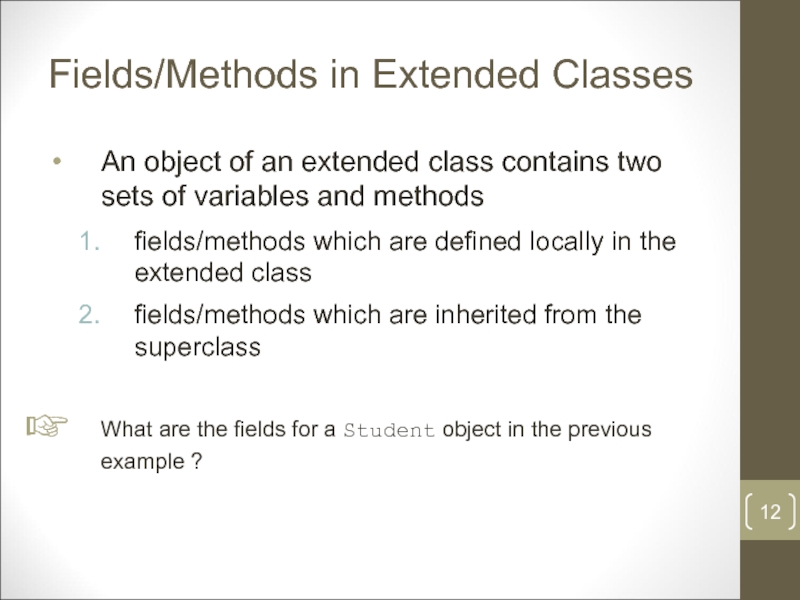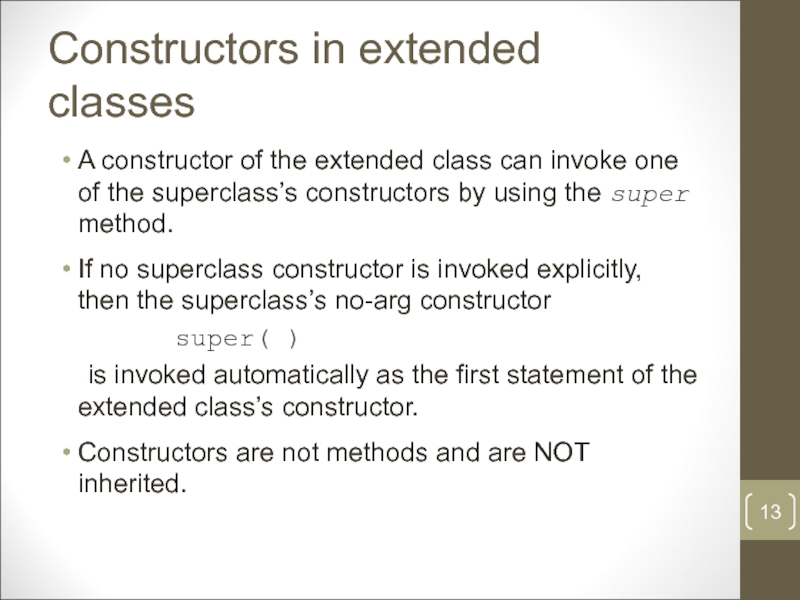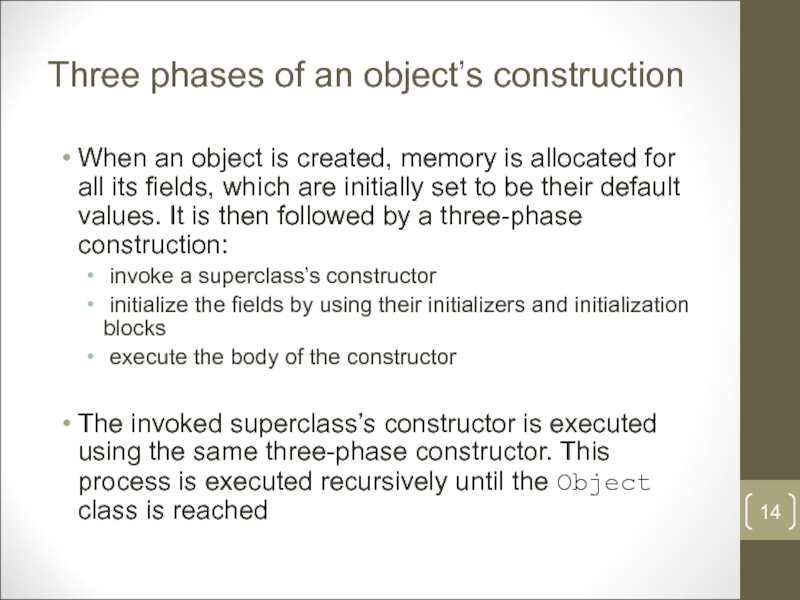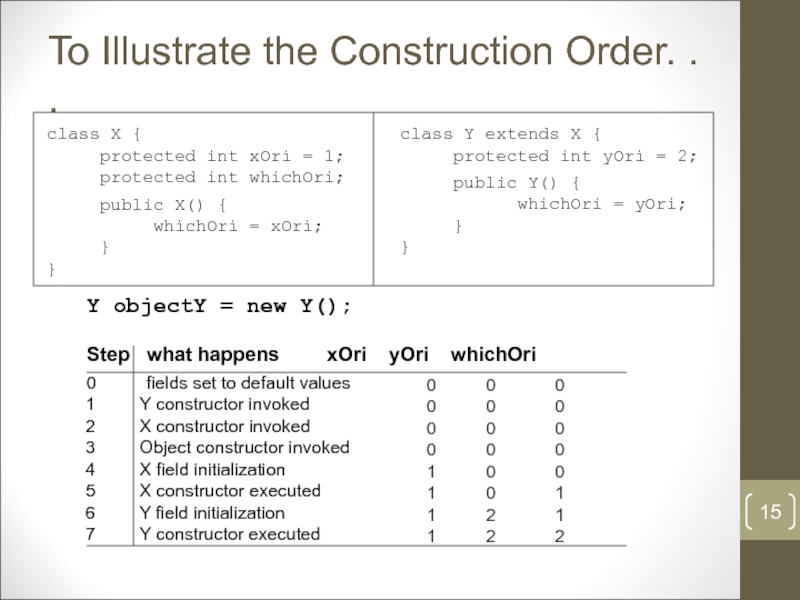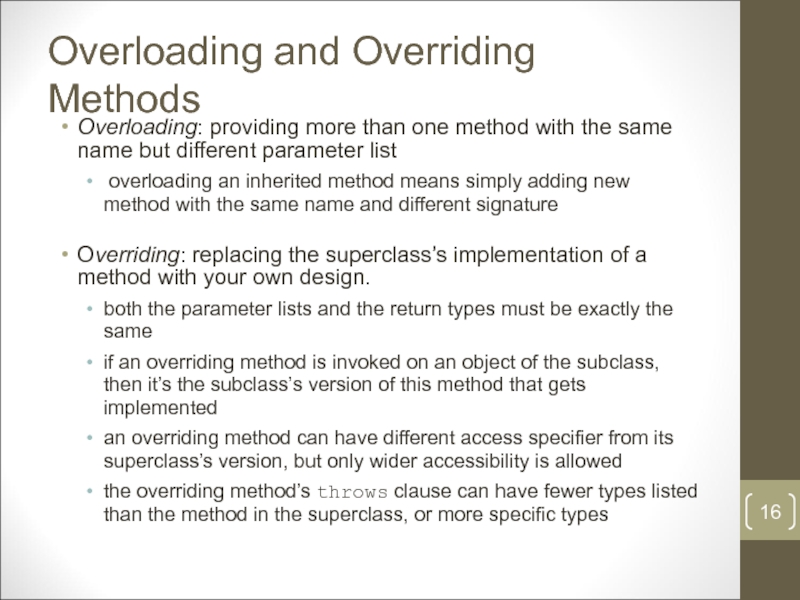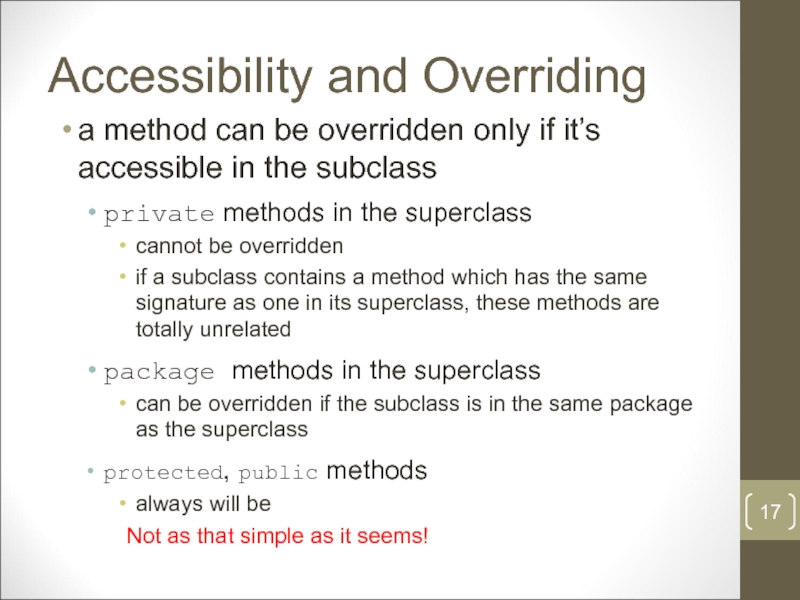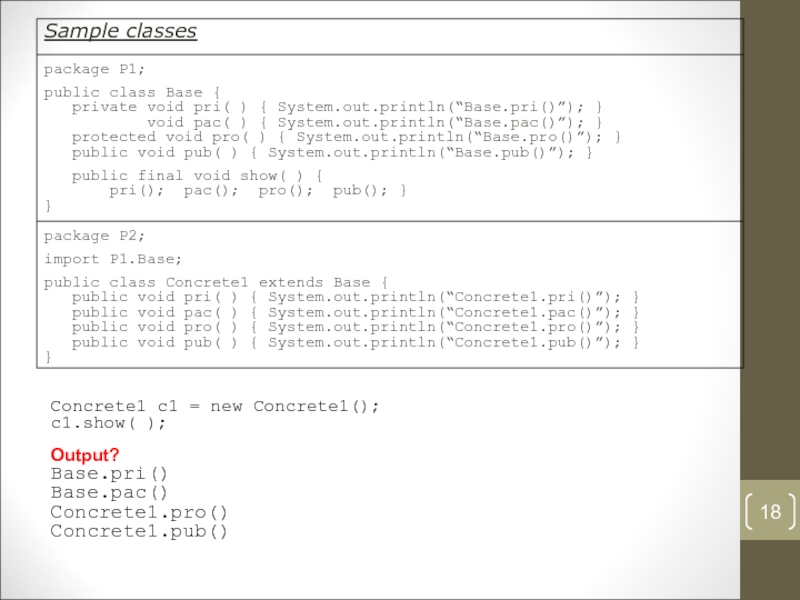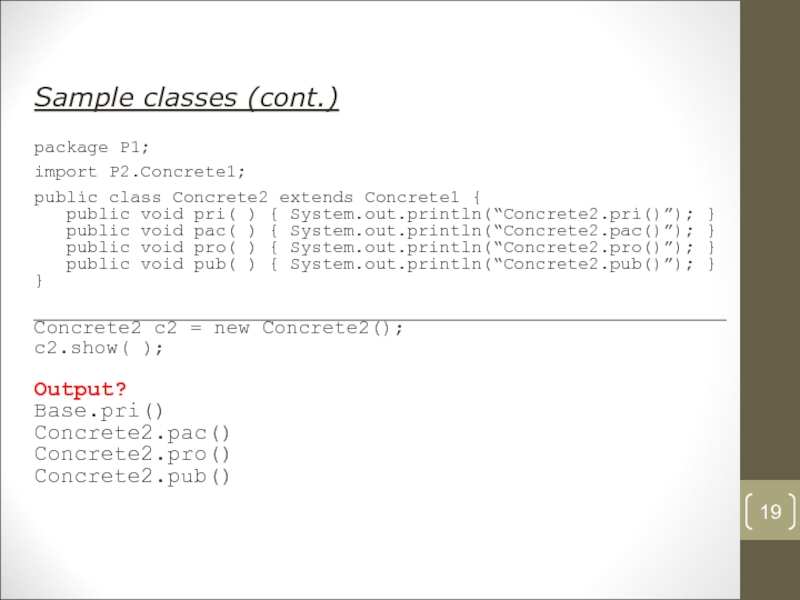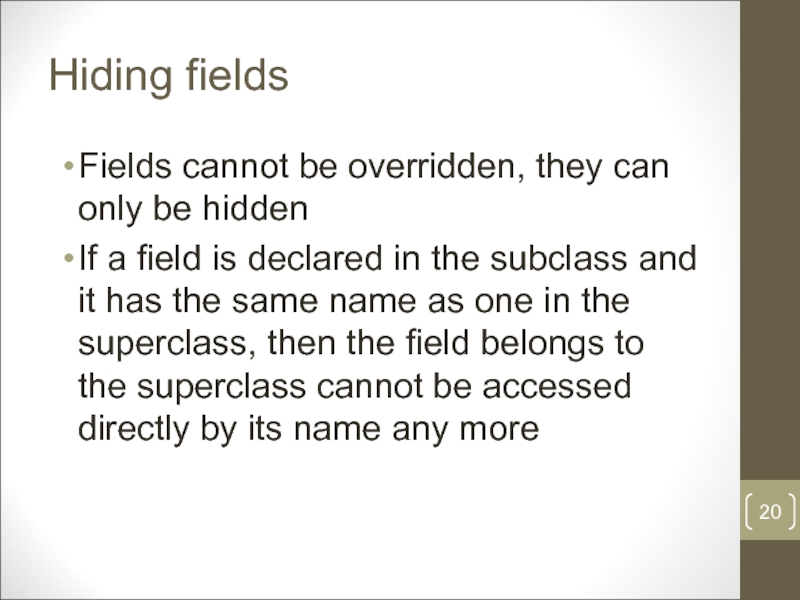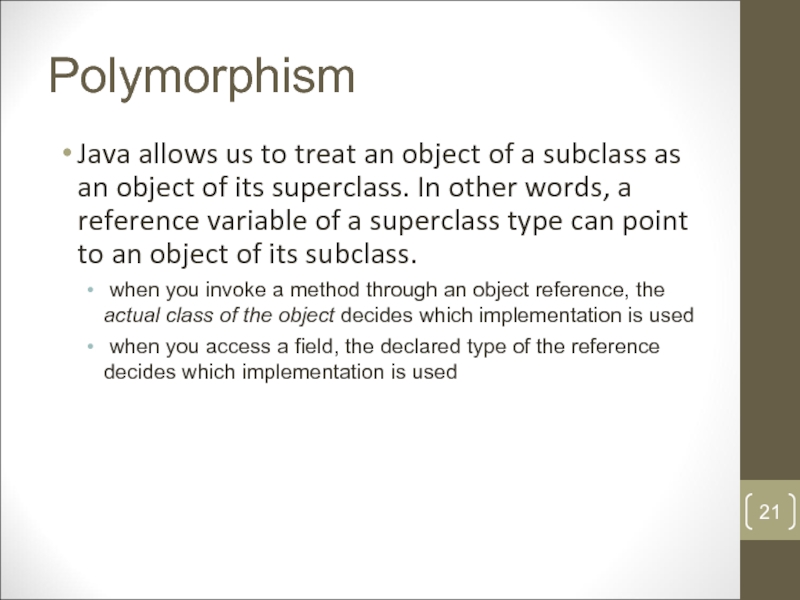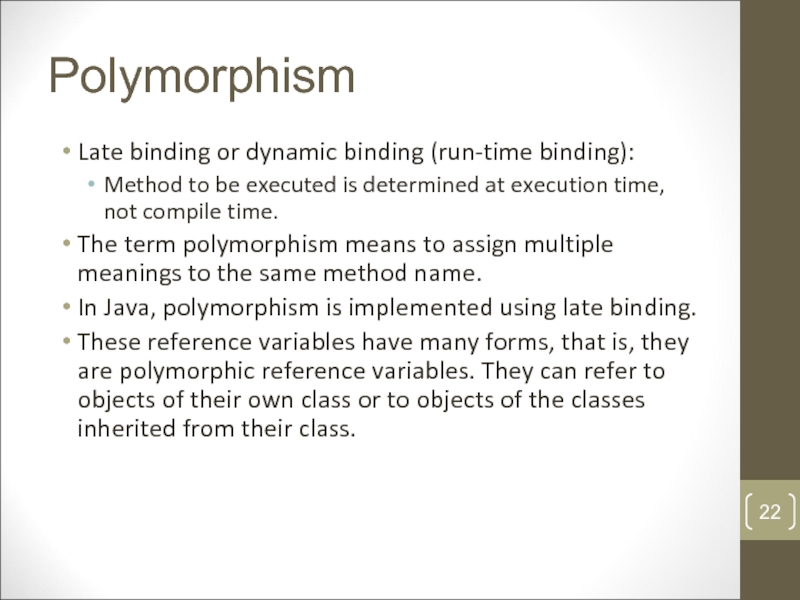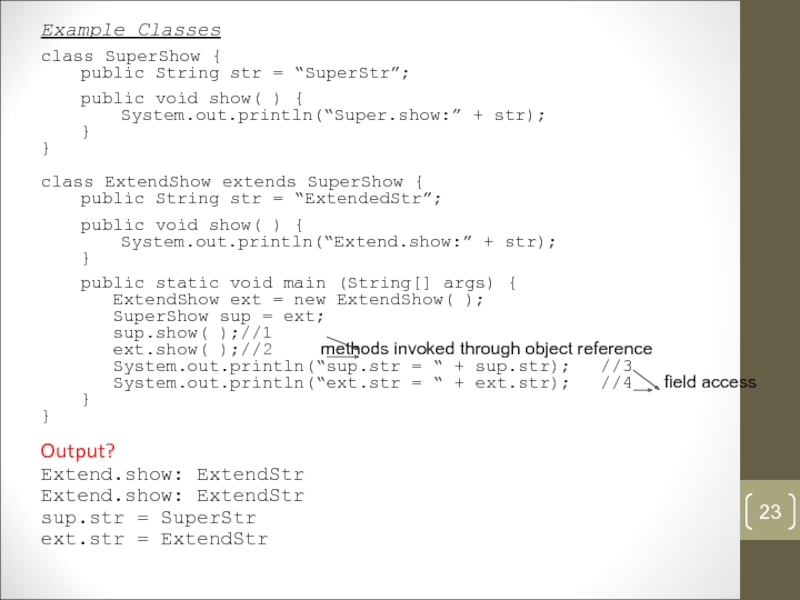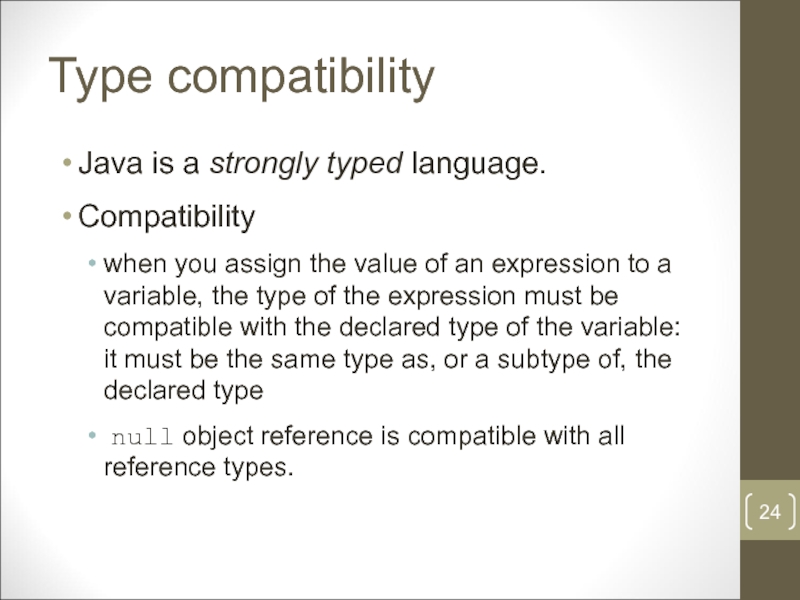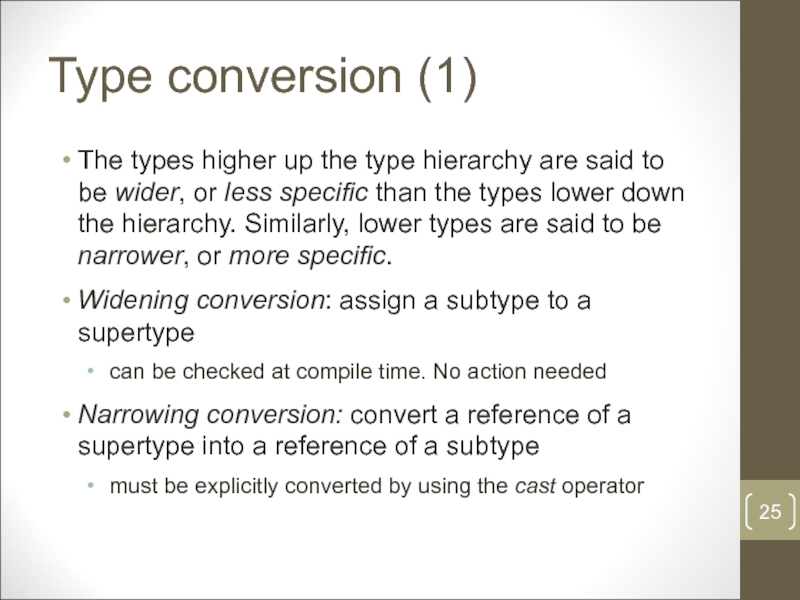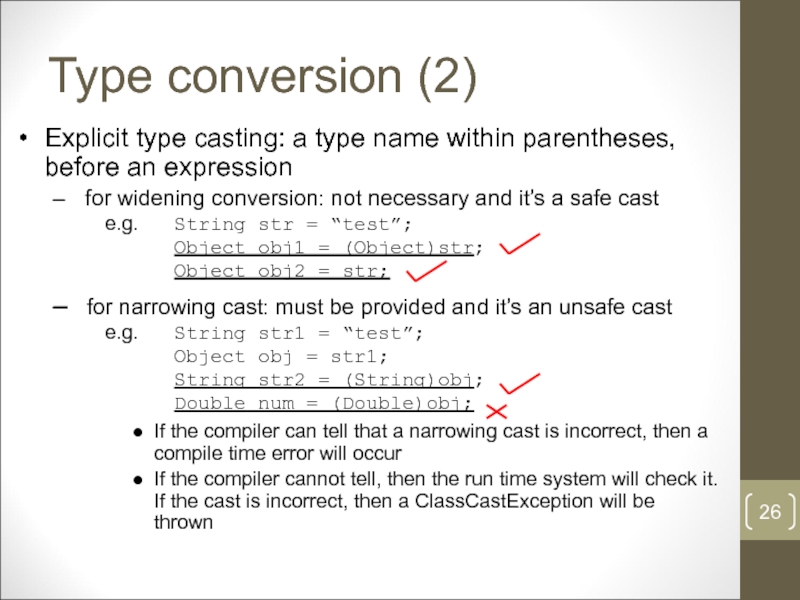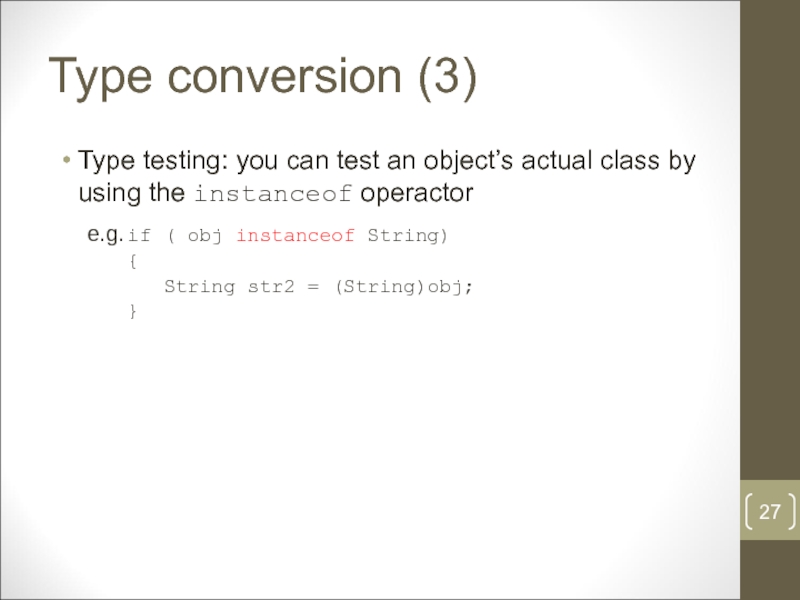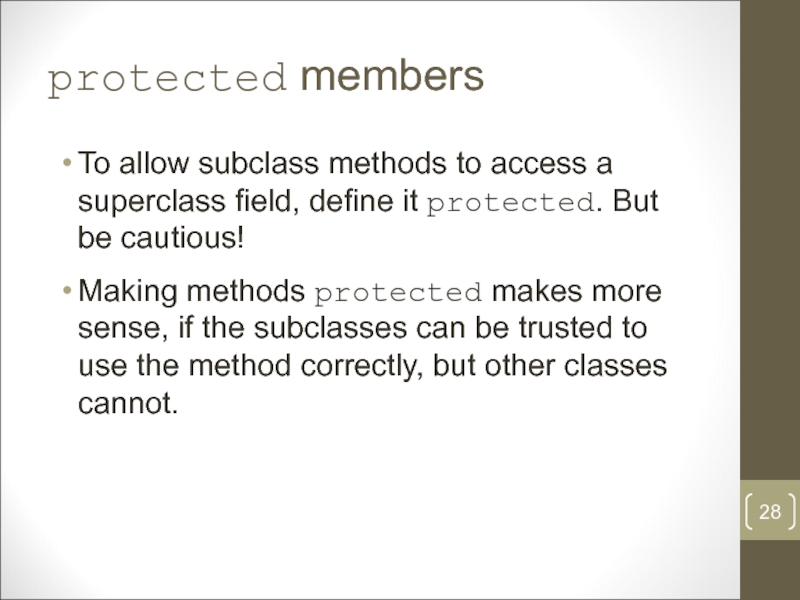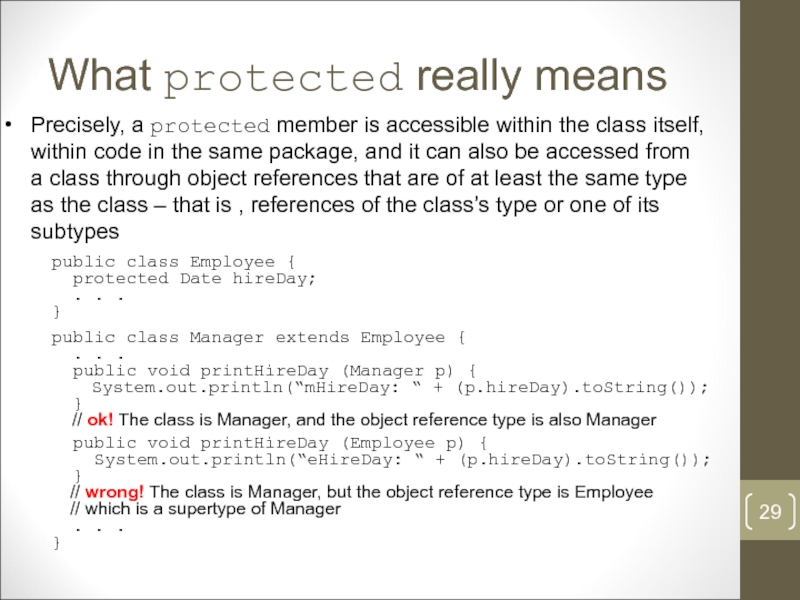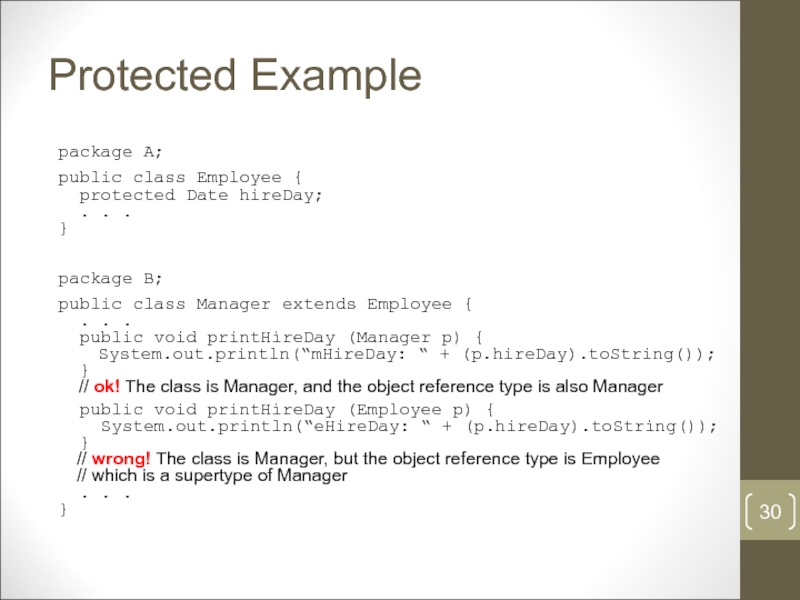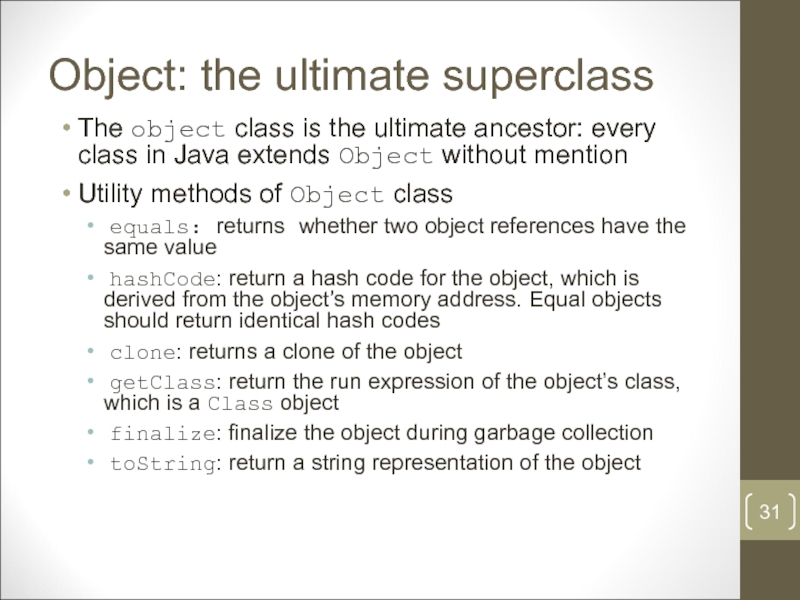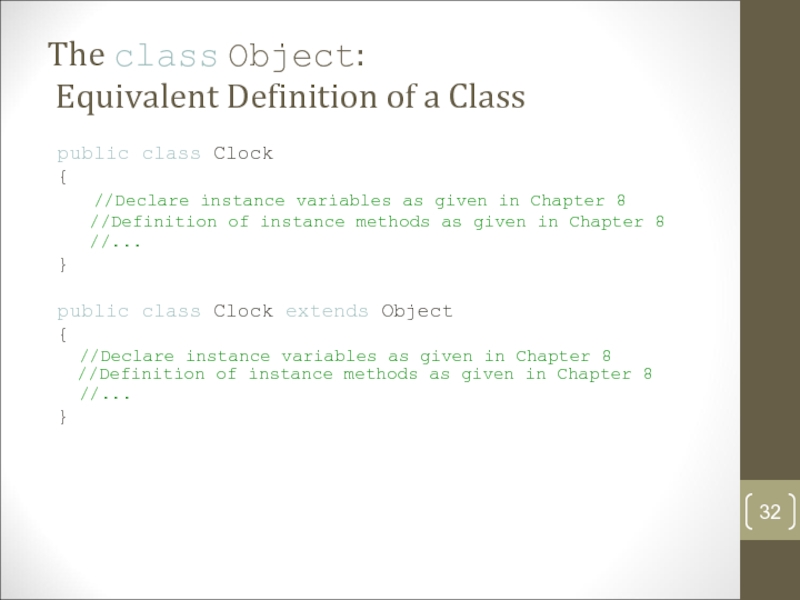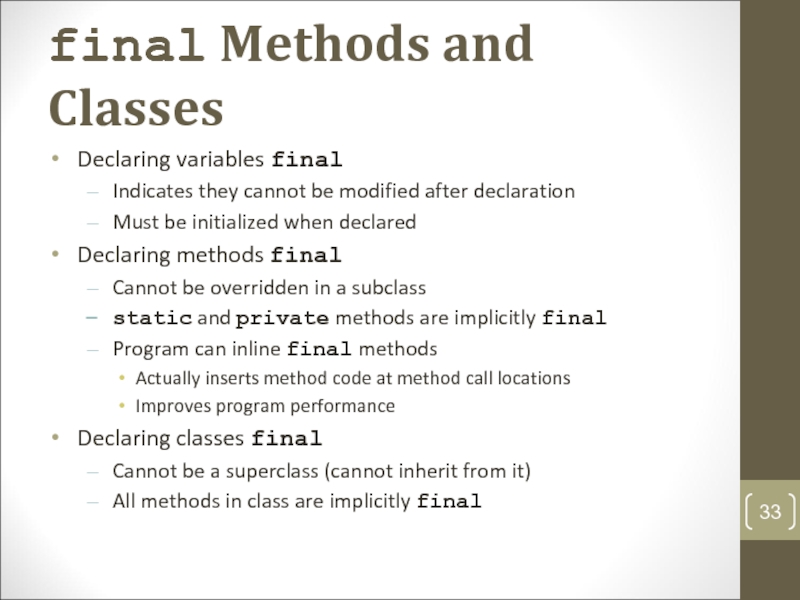- Главная
- Разное
- Дизайн
- Бизнес и предпринимательство
- Аналитика
- Образование
- Развлечения
- Красота и здоровье
- Финансы
- Государство
- Путешествия
- Спорт
- Недвижимость
- Армия
- Графика
- Культурология
- Еда и кулинария
- Лингвистика
- Английский язык
- Астрономия
- Алгебра
- Биология
- География
- Детские презентации
- Информатика
- История
- Литература
- Маркетинг
- Математика
- Медицина
- Менеджмент
- Музыка
- МХК
- Немецкий язык
- ОБЖ
- Обществознание
- Окружающий мир
- Педагогика
- Русский язык
- Технология
- Физика
- Философия
- Химия
- Шаблоны, картинки для презентаций
- Экология
- Экономика
- Юриспруденция
Object oriented programming. (Lesson 6, part 2) презентация
Содержание
- 1. Object oriented programming. (Lesson 6, part 2)
- 2. Agenda Inheritance Fields/Methods in Extended Classes Constructors
- 3. Agenda Type conversion protected members Object: the ultimate superclass
- 4. Inheritance Inheritance: you can create new classes
- 5. Inheritance "is a" relationship Inheritance "has a"
- 6. Definitions A class that is derived from
- 7. Definitions Excepting Object, which has no superclass,
- 8. Definitions Every class is an extended (inherited)
- 9. Inheritance modifier(s) class ClassName extends ExistingClassName {}
- 10. sample classes Superclass public class Person{
- 11. Inheritance Class hierarchy of previous example Object Person Student
- 12. Fields/Methods in Extended Classes An object of
- 13. Constructors in extended classes A constructor of
- 14. Three phases of an object’s construction When
- 15. To Illustrate the Construction Order. . .
- 16. Overloading and Overriding Methods Overloading: providing more
- 17. Accessibility and Overriding a method can be
- 18. Concrete1 c1 = new Concrete1(); c1.show(
- 19. Sample classes (cont.) package P1;
- 20. Hiding fields Fields cannot be overridden, they
- 21. Polymorphism Java allows us to treat an
- 22. Polymorphism Late binding or dynamic binding (run-time
- 23. Example Classes class SuperShow { public
- 24. Type compatibility Java is a strongly typed
- 25. Type conversion (1) The types higher up
- 26. Type conversion (2) Explicit type casting: a
- 27. Type conversion (3) Type testing: you can
- 28. protected members To allow subclass methods to
- 29. What protected really means Precisely, a protected
- 30. Protected Example package A; public
- 31. Object: the ultimate superclass The object class
- 32. The class Object: Equivalent Definition of
- 33. final Methods and Classes Declaring variables final
- 34. This and super keywords
Слайд 2Agenda
Inheritance
Fields/Methods in Extended Classes
Constructors in extended classes
Inherited object construction
Overloading and Overriding
Polymorphism
Type compatibility
Слайд 4Inheritance
Inheritance: you can create new classes that are built on existing
Subclass and superclass have a IsA relationship: an object of a subclass IsA(n) object of its superclass
Слайд 5Inheritance
"is a" relationship
Inheritance
"has a" relationship
Composition, having other objects as members
Example
Employee
Employee “has a” Birthdate; //Composition
Слайд 6Definitions
A class that is derived from another class is called a
The class from which the subclass is derived is called a superclass (also a base class or a parent class).
Слайд 7Definitions
Excepting Object, which has no superclass, every class has one and
Слайд 8Definitions
Every class is an extended (inherited) class, whether or not it’s
Слайд 10sample classes
Superclass
public class Person{
private String name;
public Person ( ) {
name =
}
public Person ( String initialName ) {
this.name = initialName;
}
public String getName ( ) {
return name;
}
public void setName ( String newName ) {
name = newName;
}
Subclass
public class Student extends Person {
private int studentNumber;
public Student ( ) {
super( );
studentNumber = 0;
}
public Student (String initialName, int initialStudentNumber) {
super(initialName);
studentNumber = initialStudentNumber;
}
public int getStudentNumber ( ) {
return studentNumber;
}
public void setStudentNumber (int newStudentNumber ) {
studentNumber = newStudentNumber;
}
Слайд 12Fields/Methods in Extended Classes
An object of an extended class contains two
fields/methods which are defined locally in the extended class
fields/methods which are inherited from the superclass
What are the fields for a Student object in the previous example ?
Слайд 13Constructors in extended classes
A constructor of the extended class can invoke
If no superclass constructor is invoked explicitly, then the superclass’s no-arg constructor
super( )
is invoked automatically as the first statement of the extended class’s constructor.
Constructors are not methods and are NOT inherited.
Слайд 14Three phases of an object’s construction
When an object is created, memory
invoke a superclass’s constructor
initialize the fields by using their initializers and initialization blocks
execute the body of the constructor
The invoked superclass’s constructor is executed using the same three-phase constructor. This process is executed recursively until the Object class is reached
Слайд 15To Illustrate the Construction Order. . .
Y objectY = new Y();
Step
0 fields set to default values
Y constructor invoked
X constructor invoked
Object constructor invoked
X field initialization
X constructor executed
Y field initialization
Y constructor executed
0 0 0
0 0 0
0 0 0
0 0 0
1 0 0
1 0 1
1 2 1
1 2 2
class Y extends X {
protected int yOri = 2;
public Y() {
whichOri = yOri;
}
}
class X {
protected int xOri = 1;
protected int whichOri;
public X() {
whichOri = xOri;
}
}
Слайд 16Overloading and Overriding Methods
Overloading: providing more than one method with the
overloading an inherited method means simply adding new method with the same name and different signature
Overriding: replacing the superclass’s implementation of a method with your own design.
both the parameter lists and the return types must be exactly the same
if an overriding method is invoked on an object of the subclass, then it’s the subclass’s version of this method that gets implemented
an overriding method can have different access specifier from its superclass’s version, but only wider accessibility is allowed
the overriding method’s throws clause can have fewer types listed than the method in the superclass, or more specific types
Слайд 17Accessibility and Overriding
a method can be overridden only if it’s accessible
private methods in the superclass
cannot be overridden
if a subclass contains a method which has the same signature as one in its superclass, these methods are totally unrelated
package methods in the superclass
can be overridden if the subclass is in the same package as the superclass
protected, public methods
always will be
Not as that simple as it seems!
Слайд 18
Concrete1 c1 = new Concrete1();
c1.show( );
Output?
Base.pri()
Base.pac()
Concrete1.pro()
Concrete1.pub()
Sample classes
package P1;
public class Base {
void pac( ) { System.out.println(“Base.pac()”); }
protected void pro( ) { System.out.println(“Base.pro()”); }
public void pub( ) { System.out.println(“Base.pub()”); }
public final void show( ) {
pri(); pac(); pro(); pub(); }
}
package P2;
import P1.Base;
public class Concrete1 extends Base {
public void pri( ) { System.out.println(“Concrete1.pri()”); }
public void pac( ) { System.out.println(“Concrete1.pac()”); }
public void pro( ) { System.out.println(“Concrete1.pro()”); }
public void pub( ) { System.out.println(“Concrete1.pub()”); }
}
Слайд 19Sample classes (cont.)
package P1;
import P2.Concrete1;
public class Concrete2 extends Concrete1 {
public void pac( ) { System.out.println(“Concrete2.pac()”); }
public void pro( ) { System.out.println(“Concrete2.pro()”); }
public void pub( ) { System.out.println(“Concrete2.pub()”); }
}
Concrete2 c2 = new Concrete2();
c2.show( );
Output?
Base.pri()
Concrete2.pac()
Concrete2.pro()
Concrete2.pub()
Слайд 20Hiding fields
Fields cannot be overridden, they can only be hidden
If a
Слайд 21Polymorphism
Java allows us to treat an object of a subclass as
when you invoke a method through an object reference, the actual class of the object decides which implementation is used
when you access a field, the declared type of the reference decides which implementation is used
Слайд 22Polymorphism
Late binding or dynamic binding (run-time binding):
Method to be executed
The term polymorphism means to assign multiple meanings to the same method name.
In Java, polymorphism is implemented using late binding.
These reference variables have many forms, that is, they are polymorphic reference variables. They can refer to objects of their own class or to objects of the classes inherited from their class.
Слайд 23Example Classes
class SuperShow {
public String str = “SuperStr”;
public void show( )
System.out.println(“Super.show:” + str);
}
}
class ExtendShow extends SuperShow {
public String str = “ExtendedStr”;
public void show( ) {
System.out.println(“Extend.show:” + str);
}
public static void main (String[] args) {
ExtendShow ext = new ExtendShow( );
SuperShow sup = ext;
sup.show( ); //1
ext.show( ); //2 methods invoked through object reference
System.out.println(“sup.str = “ + sup.str); //3
System.out.println(“ext.str = “ + ext.str); //4 field access
}
}
Output?
Extend.show: ExtendStr
Extend.show: ExtendStr
sup.str = SuperStr
ext.str = ExtendStr
Слайд 24Type compatibility
Java is a strongly typed language.
Compatibility
when you assign the
null object reference is compatible with all reference types.
Слайд 25Type conversion (1)
The types higher up the type hierarchy are said
Widening conversion: assign a subtype to a supertype
can be checked at compile time. No action needed
Narrowing conversion: convert a reference of a supertype into a reference of a subtype
must be explicitly converted by using the cast operator
Слайд 26Type conversion (2)
Explicit type casting: a type name within parentheses, before
for widening conversion: not necessary and it’s a safe cast
e.g. String str = “test”;
Object obj1 = (Object)str;
Object obj2 = str;
for narrowing cast: must be provided and it’s an unsafe cast
e.g. String str1 = “test”;
Object obj = str1;
String str2 = (String)obj;
Double num = (Double)obj;
If the compiler can tell that a narrowing cast is incorrect, then a compile time error will occur
If the compiler cannot tell, then the run time system will check it. If the cast is incorrect, then a ClassCastException will be thrown
Слайд 27Type conversion (3)
Type testing: you can test an object’s actual class
e.g. if ( obj instanceof String)
{
String str2 = (String)obj;
}
Слайд 28protected members
To allow subclass methods to access a superclass field, define
Making methods protected makes more sense, if the subclasses can be trusted to use the method correctly, but other classes cannot.
Слайд 29What protected really means
Precisely, a protected member is accessible within the
public class Employee {
protected Date hireDay;
. . .
}
public class Manager extends Employee {
. . .
public void printHireDay (Manager p) {
System.out.println(“mHireDay: “ + (p.hireDay).toString());
}
// ok! The class is Manager, and the object reference type is also Manager
public void printHireDay (Employee p) {
System.out.println(“eHireDay: “ + (p.hireDay).toString());
}
// wrong! The class is Manager, but the object reference type is Employee
// which is a supertype of Manager
. . .
}
Слайд 30Protected Example
package A;
public class Employee {
protected Date
. . .
}
package B;
public class Manager extends Employee {
. . .
public void printHireDay (Manager p) {
System.out.println(“mHireDay: “ + (p.hireDay).toString());
}
// ok! The class is Manager, and the object reference type is also Manager
public void printHireDay (Employee p) {
System.out.println(“eHireDay: “ + (p.hireDay).toString());
}
// wrong! The class is Manager, but the object reference type is Employee
// which is a supertype of Manager
. . .
}
Слайд 31Object: the ultimate superclass
The object class is the ultimate ancestor: every
Utility methods of Object class
equals: returns whether two object references have the same value
hashCode: return a hash code for the object, which is derived from the object’s memory address. Equal objects should return identical hash codes
clone: returns a clone of the object
getClass: return the run expression of the object’s class, which is a Class object
finalize: finalize the object during garbage collection
toString: return a string representation of the object
Слайд 32The class Object:
Equivalent Definition of a Class
public class Clock
{
//Definition of instance methods as given in Chapter 8
//...
}
public class Clock extends Object
{
//Declare instance variables as given in Chapter 8 //Definition of instance methods as given in Chapter 8
//...
}
Слайд 33final Methods and Classes
Declaring variables final
Indicates they cannot be modified after
Must be initialized when declared
Declaring methods final
Cannot be overridden in a subclass
static and private methods are implicitly final
Program can inline final methods
Actually inserts method code at method call locations
Improves program performance
Declaring classes final
Cannot be a superclass (cannot inherit from it)
All methods in class are implicitly final
